We’ve been thinking a lot about outdoor activities that embrace social distancing. There’s kayaking, SUPing, biking, backpacking, hiking, running, and outdoor rock climbing. The trouble is that many of these past times require a high level of physical fitness, lots of experience, and a big investment in gear. But there’s one activity—via ferrata climbing—that nearly anyone can do. Via ferratas, which involve climbing rock faces with pre-placed hand and foot holds, and safety cables, are the great outdoor equalizer. Via ferratas’ popularity in the U.S. has increased with the appearance of COVID-19 as the public turns to the outdoors for a socially distanced “earned” adventure. With the proper equipment and a quick lesson on how to use it properly, nearly anyone can have a fun alpine experience. And, chances are, if you live near a mountain, ski resort, or cliff, there’s one near you. This accessible and egalitarian way to climb offers one of the best socially distant options for a responsible summer escape.
What is a Via Ferrata?
Via ferrata is an Italian term that mean’s iron road, or path (in Germany and Austria it’s called klettersteig). They involve a network of steel ladders and cables that are anchored into the side of a cliff or mountain and allow people to climb rock faces and ridgelines that would normally only be accessible to experienced alpinists and rock climbers. You wear a climbing harness, and clip into a continuous system of safety cables. Sometimes you use natural foot and handholds, but in general you grab metal rungs that snake up and across rock faces. Routes wind through hidden alpine forests, or snake along wide, flat ledges before they again ascend cliff bands. Many via ferratas feature cable-protected suspension bridges that cross canyons, waterfalls and creeks. Some end with zip-lines. You are “clipped in” with two specialized, self-locking carabiners. If you can climb a ladder, you can ascend a via ferrata. They are climbed by people of all ages (generally the recommended minimum age is 10). And, other than a quick session on how to use the gear, they don’t require any experience.
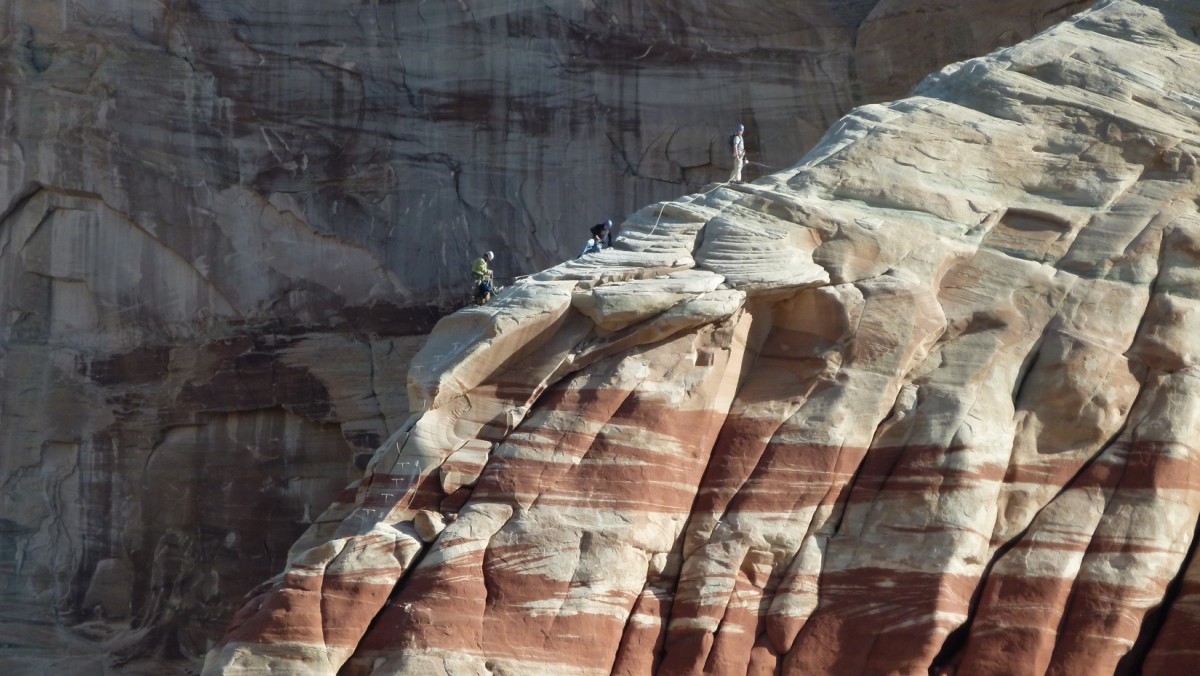
There are more than 400 via ferratas in Italy alone, with many more in France, Austria, China, Canada and Australia. They are becoming increasingly popular in North America as many ski areas are building them to attract summer and fall guests. One company, Adventure Partners Attractions, out of Page, AZ, has designed and installed the routes and walkways at Jackson Hole (WY), Mammoth (CA), Royal Gorge Bridge and Park (CO), Amangiri Resort (UT), Taos (CA) and Arapahoe Basin (CO). The Taos Via Ferrata should open by August, with the one at Arapahoe Basin planning a September debut. “Via ferratas are like a ‘gateway drug’ to rock climbing,” says Mike Friedman, managing partner at Adventure Partners Attractions. “They encourage people who would otherwise shy away from belayed climbing and exposure to venture into the world of the mountaineer.”
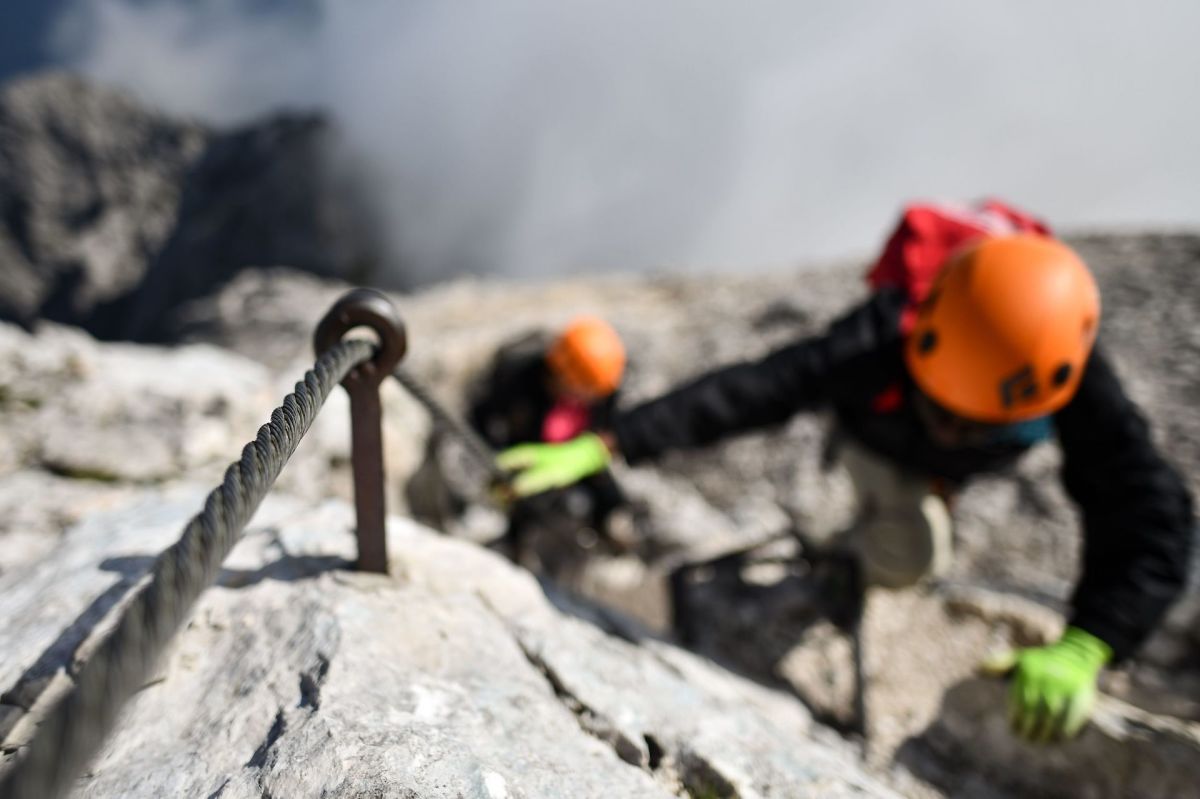
Via Ferrata Equipment
Via ferrata gear includes special self-locking carabiners, energy absorbing lanyards, a harness and a helmet. You can buy your own kit for under $200. You’ll also want sturdy hiking or running shoes and a small day-pack for water and snacks. Your best bet is to rent equipment at an outdoor shop near your intended route. If you are uninitiated in the sport or area, consider hiring a local guide; that way you’ll get the right gear and instruction, plus information on the history, geology and biology of the area.
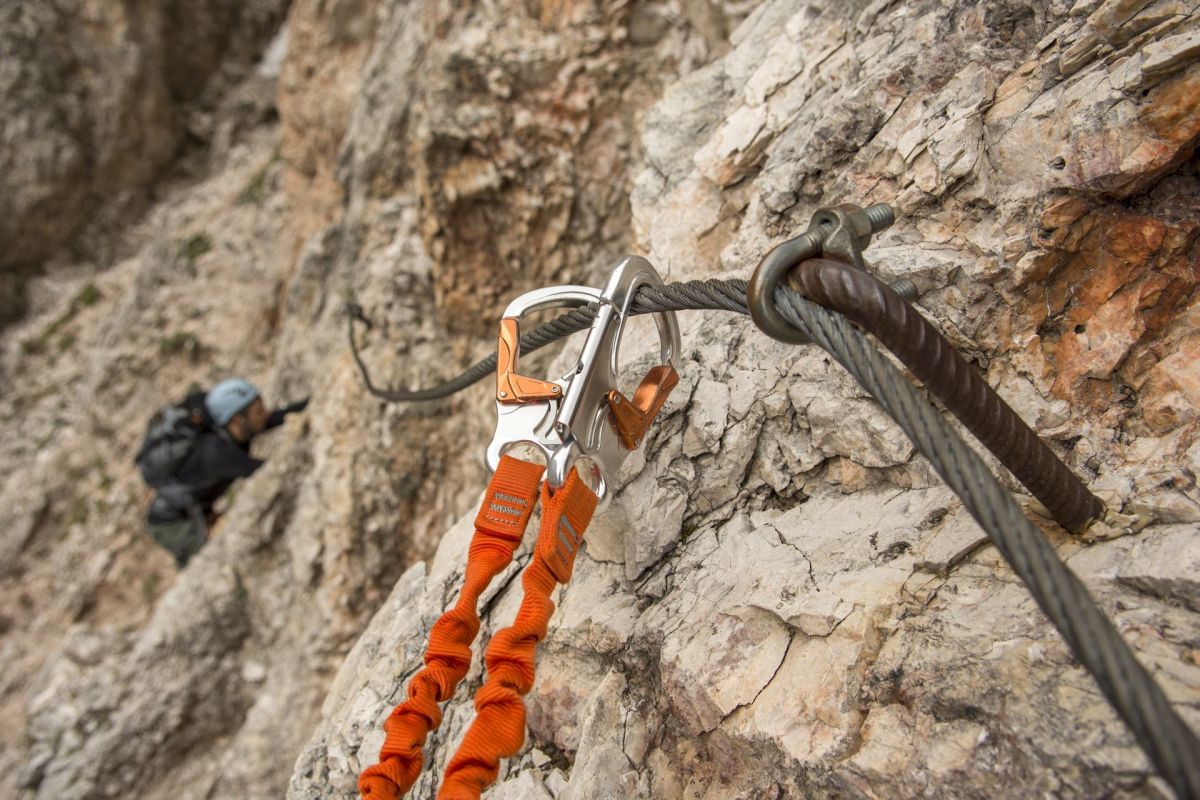
Via Ferrata Cost
In Europe, via ferratas are generally free and accessible to anyone with proper gear. In the U.S., there’s a move toward open-to-the-public routes, but the majority are developed by guiding companies, ski areas and even hotels. Celebrity-favorite luxury hotel Amangiri in Southern Utah has one of the most scenic via ferratas in the country, but you need to be a guest to use it. Due to the federal Ski Area Recreational Enhancement Opportunity Act of 2011, many ski areas operating on U.S. Forest Service lands are adding via ferratas, along with zip lines, “sky” swings, and ropes courses to drum up summer business.
Via Ferrata History
Pre-protected climbing routes on cliffs and mountains isn’t new. Ancient civilizations chiseled hand and footholds into cliffs to reach cave dwellings (and to secure escape routes in case of an attack). The Mayan, Incan, and Anasazi civilizations all built wood and rope ladders and carved handholds to access cliff bands. By the 1800s, mountain tourism in Europe became so popular, particularly in the Alps, that guides were facilitating access up peaks by chiseling steps, fixing ropes and erecting wooden ladders. During World War I, when Italy was battling Austria-Hungarian troops, soldiers built massive via ferratas that tunneled through cliffs and ascended steep ridges to move troops and supplies and to hold defensive lines. Many of those routes have been upgraded with modern equipment and provide an inspirational glimpse into history.
The Best Via Ferratas in the World
There are probably close to 3,000 via ferratas in Europe and North America alone, with many more going up in China, South America, and Australia. They’ve sprouted up in Canada, from Alberta to Quebec, to B.C., as well as south of the border in Mexico. But in light of the COVID-19 pandemic, we’ll focus on some of the new routes in the U.S. so you can stay more local while staying active.
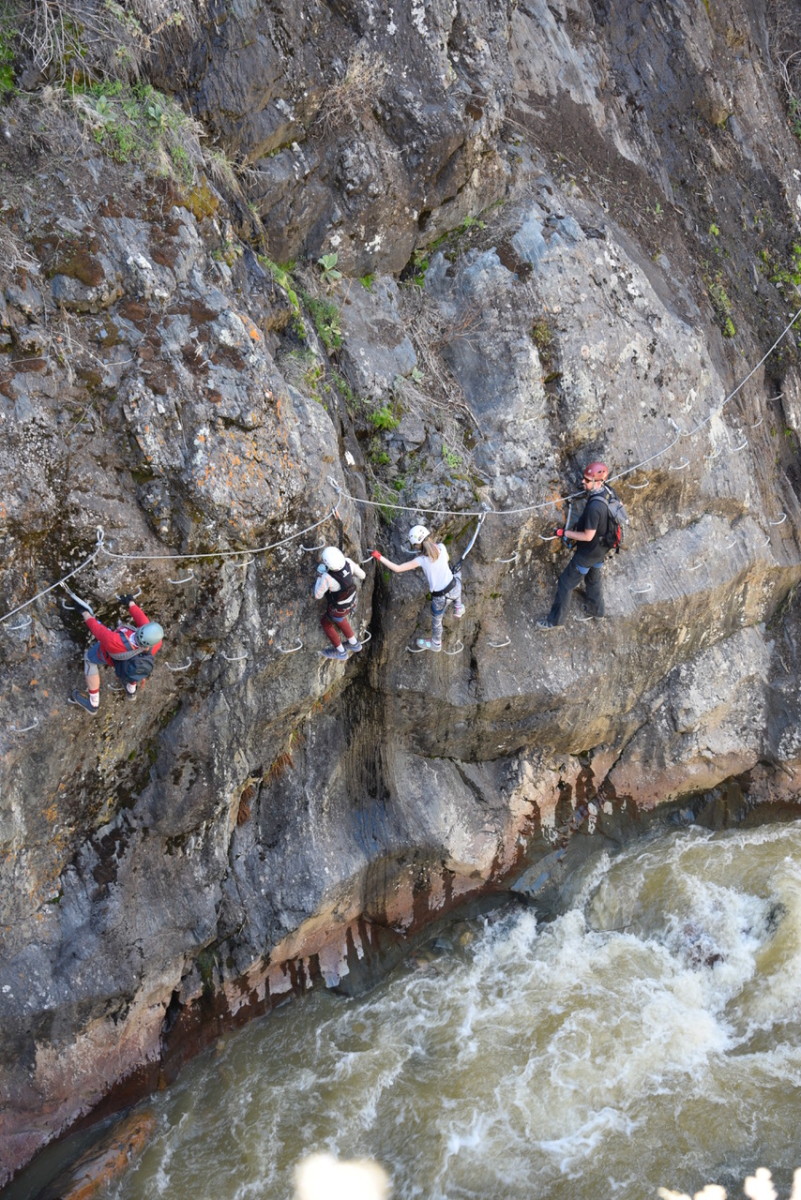
Ouray Via Ferrata Ouray, CO
The newest via ferrata in the U.S. opened this summer (2020), is free to the public and built to European standards. The sleepy town Ouray, tucked into the San Juan Mountains, started attracting tourists when it developed a world-class ice climbing park, and its new via ferrata was built to help attract summer visitors. The cables and rungs ascend the steep, rocky cliffs that surround the town. There are more than 4,000 linear feet of anchored cable/protected rung-enhanced trail, a 35-foot cable bridge across the Uncompahgre Gorge and a 75-foot “sky” bridge. You can help support future via ferrata development and maintenance on their site, and if you want instruction, or need to rent gear, San Juan Mountain Guides San Juan Mountain Guides can hook you up.
Jackson Hole Via Ferrata Jackson, WY
You don’t have to climb the Grand Teton to enjoy the rock surrounding the Jackson Hole Mountain Resort, which has developed an extensive network of via ferratas on the cliff bands that stretch along the top of the ski area. The original routes opened more than a year ago, but for 2020, the resort added four new via ferratas—and a lot more vertical territory. You take the Bridger gondola to the top, then walk a short distance to the start the climbs. You’ll climb next to chutes that you’ve always wanted to drop during the winter months. Highlights include a 120-foot suspension bridge and bird’s-eye views of the surrounding peaks. A full day, private guided trip is $535 dollars ($395 per person for a half day), so in addition to possible vertigo, there’s some sticker shock involved. Groups are guided by Jackson Hole Mountain Guides.
Telluride Via Ferrata Telluride, CO
This via ferrata was in the works for years prior to its becoming “legal” in 2019. The 1.5-mile-long route is tucked into the box canyon just outside of Telluride and traverses the side of 12,785-foot Ajax Peak. Expect some breathtaking overhangs (literally, as the town of Telluride is at 8,750-feet) and a section called “The Main Event” that darts across a slightly overhanging, blank face, a couple of hundred feet above the ground. It was “unofficially” built by climbers, with planning and construction spearheaded by Chuck Kroger, a local who spent many years plotting out the route and drilling in anchors. The cable system isn’t continuous (you walk on flat trails between cliff sections), but the route is easy to follow and well-protected. The setting is spectacular, with excellent views of Bridal Veil Falls (at 365-feet, the longest free-falling waterfall in Colorado), the town, and the surrounding peaks. There’s no charge for using the via ferrata; Telluride Adventures can provide guides and gear if you need any help. There’s also a fund set up to maintain the route and preserve its free access to the public.
View this post on Instagram
Every day is a good day on the Tahoe Via
. . . #adventuredoneright #climbskitrek #climbtahoevia
Tahoe Via Ferrata Olympic Valley, CA
This via ferrata just keeps getting better. The original four routes built into the cliffs above Squaw Valley Resort opened in the fall of 2018. It’s owned and operated by a local company and only accessible to guided groups. The routes follow the cliff bands of the 1,000-foot “Tram Face” above the ski area. For summer, 2020, a new route, the Loophole joins the Skyline Traverse, Sundial Arête and the Great Escape, making a total of four routes on Tram Face. The Loophole navigates the lower half of tram face and covers fairly moderate terrain with short steep sections sprinkled throughout before culminating in the Olympic Valley Overlook. This prominent feature towers over the Village at Squaw Valley and is the perfect place to get that IG hero shot. It makes for a fun, 2.5-hour tour. (If you want to climb to the summit of Tram Face, plan on a four-hour trip.) You can get 2.5 hours of guiding and the necessary equipment for $90 per person if you have a party of six, or $127 per person for the four-hour tour. The rock is beautiful (golden Sierra Nevada granite), and you’ll get excellent views of the surrounding Sierra Nevada, not to mention a unique view of the ski runs of legendary Squaw Valley Resort in the summer months.
Mammoth Mountain Via Ferrata Mammoth, CA
Situated on the cliffs below the Caldera Overlook at Mammoth Mountain, this via ferrata is accessed by the Panorama Gondola. The routes are spread out on about 300-feet of cliff and are about 180-feet in length. There are six routes, total, with five for beginner and intermediate “climbers” and the sixth, named The Nose, after the eponymous Yosemite feature, is more strenuous. Cost is $99 per person Monday-Thursday ($119 per person Friday-Sunday) for a three-hour tour.
Royal Gorge Via Ferrata Cañon City, CO
The Royal Gorge is a six-mile section of canyon on the Arkansas River that cuts 1,250 feet into the bedrock, making for narrow canyon flanked by high, granite cliffs on both sides. There’s a private bridge that crosses the canyon, and, surprisingly enough, a first rate “amusement” park. You can zip-line, ride the big swing, take a gondola, or, enjoy the latest feature, a spectacular via ferrata that starts midway up the 1,000-foot canyon wall and leads you up and over a gorgeous 500-foot arête. Built nearby are three routes that go from halfway up the canyon to the rim. The exposure is spectacular—even for seasoned climbers. Plus there’s a free-standing pinnacle you access from a cable bridge. The park is open year-round, weather permitting. Price starts at $135 per person (in addition to the Park’s entry fee of $27 for adults).
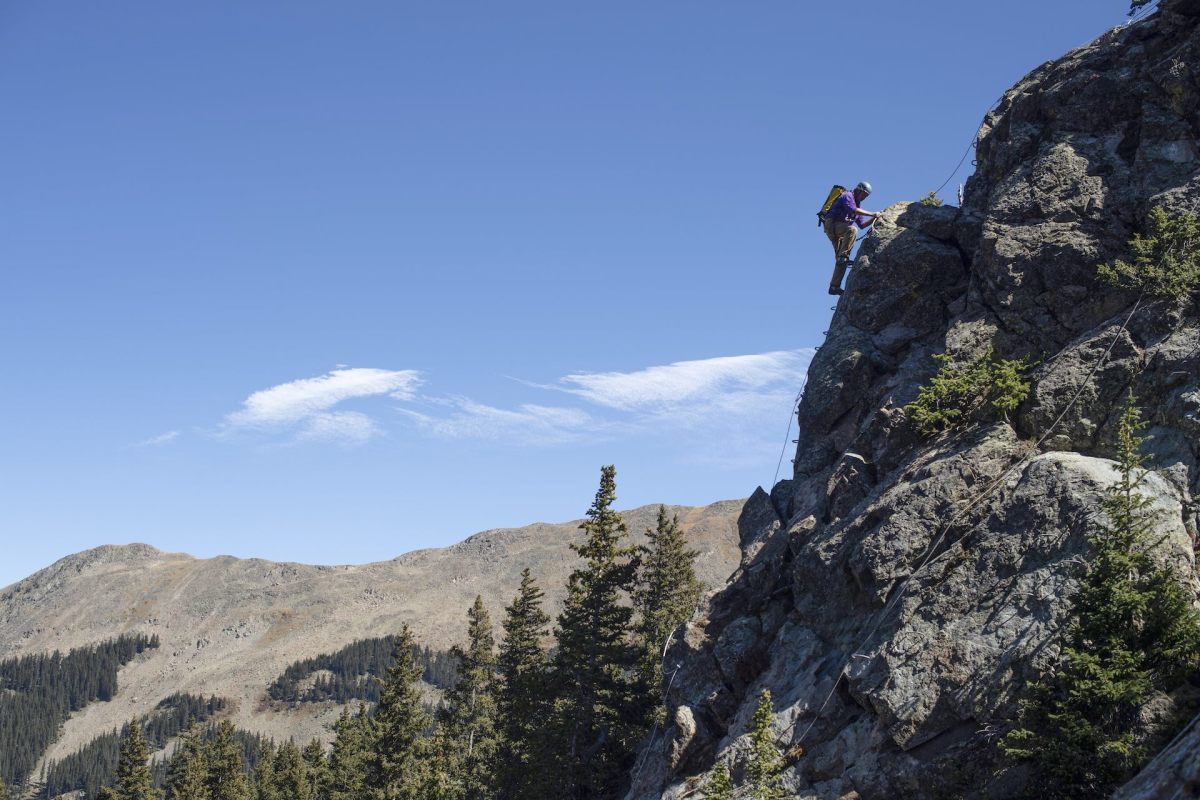
Taos Ski Valley Via Ferrata Taos, NM
Situated at 11,000 feet in the sub-alpine ecosystem, of Kachina Peak, this via ferrata offers challenges for beginner through advanced climbers. There’s a 100-foot aerial walkway, and a two-cable “cat walk.” Novices can experience the thrill of cabled mountain travel under the supervision of a guide, and then progress to vertical terrain with post-card views of the Rio Hondo and Wheeler Peak Wilderness. The all-new mountain experience was installed by Adventure Partners Attractions. Prices have yet to be set. The via ferrata opens in August.
Other U.S. Via Ferrata Classics
Mount Ogden Via Ferrata Waterfall Canyon, UT
This was one of the first via ferratas established in the U.S. and is still one of the very best. Local landowner, Chris Peterson, worked with mountaineering legend, Jeff Lowe, to chart out routes. Teams of climbers, equipped with ropes and drills, fixed the cables and metal rungs. The trio of routes is the closest you’ll get to rock climbing on a U.S. via ferrata, in fact, all the routes have climbing ratings for people who want to clip in for safety but only use the natural rock. Route one is the easiest. It “goes” at 5.7 with natural holds but is much easier if you use the metal rungs. Route 2 is an intermediate circuit (5.9 with a 5.11 crux), while Route 3 is challenging, even with the metal rungs (it would probably be rated 5.13 if anyone tried to free climb it). The three via ferratas each rise about 400 feet off the deck; there’s a station at the base for practice. Utah Adventure Center charges about $110 per person, gear included and no experience necessary. Plus there’s a hidden waterfall at the top of the canyon.
Red River Gorge Via Ferrata Red River Gorge, Kentucky
Operated by the Southeast Mountain Guides, this via ferrata sits on 12 acres of private property. It’s nearly a mile in length, with six sections; two for beginners, one intermediate, two advanced, and one for experts. There are “exits” so you don’t need to complete the entire course in one go. The routes traverse a horseshoe-shaped sandstone canyon; there are plenty of natural hand and footholds, but you’re protected by continuous cables. Highlights include a big deck with eagle-nest views of the canyon, plus a 70-foot long suspension bridge. Rates for the via ferrata are reasonable—about $52 per day, per person, and include gear, instruction and a day pass so you can explore the sections at your own rate (and do them more than once). If you decide via ferrata is too tame for your taste, the Red River Gorge is home to some of the best climbing in the Southeast. SMG’s offers guided rock climbing and rappelling; either on their property or throughout the RRG region. Reservations are required.
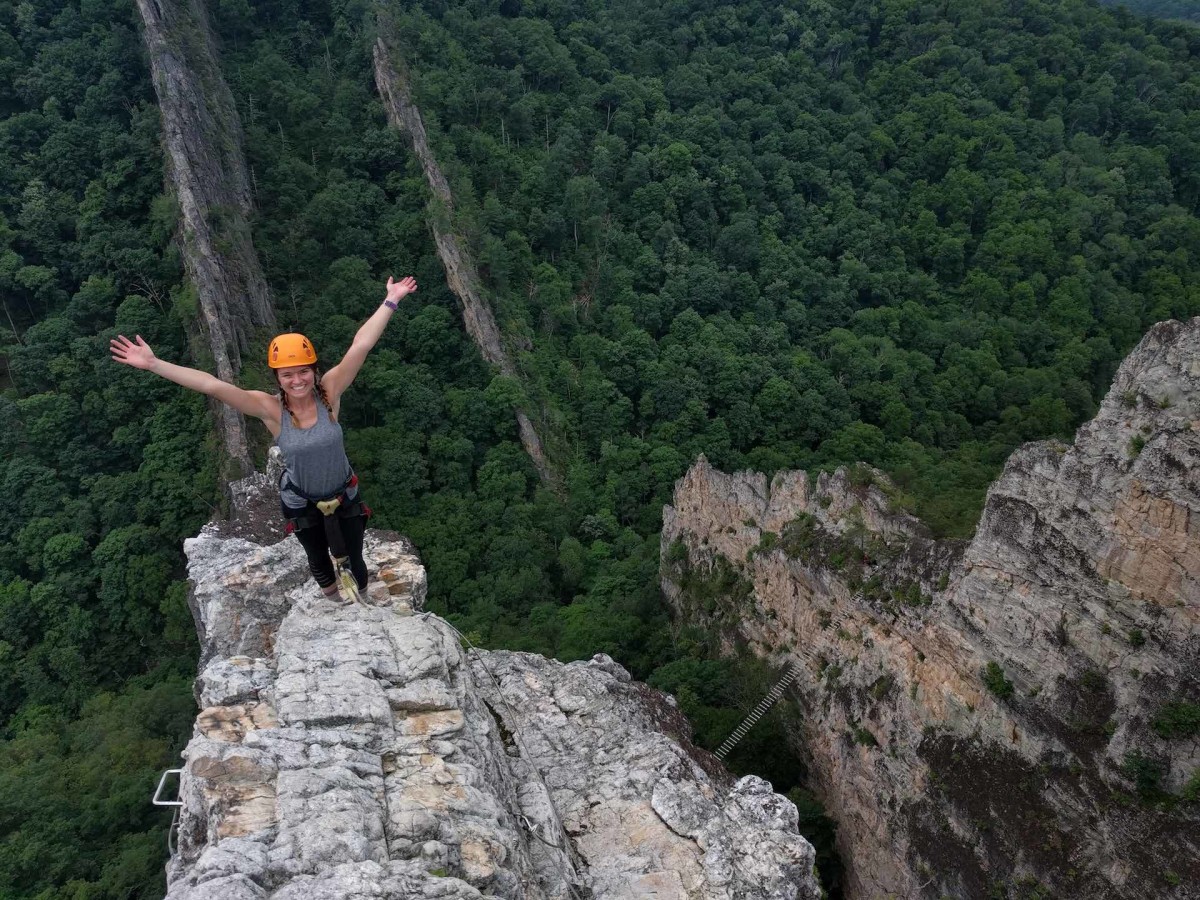
Nelson Rocks Circleville, WV
NROCKS is in the North Fork Valley, named after the North Fork of the South Branch Potomac River (the same Potomac that goes through Washington, D.C.). The via ferrata tour has about 1-mile of steel cable and a 200-foot-long swinging bridge that’s 150 feet off the ground—other parts of the route are close to 300 feet off the deck! The route, including the hike into the rocks, is about three miles. You gaze across the Allegheny mountain range, with postcard views of West Virginia’s highest point, Spruce Knob (4,863 ft). The site is right next to the Germany Valley, which has more limestone caves than almost any other area in the country; yes, you can get guided cave tours at NROCKS, as well. The adventure park also has a sweet Canopy Tour consisting of 12 ziplines, 3 skybridges, and a 40-foot rappel at the end. You can also sign up for top rope climbing on the beautiful Tuscarora Sandstone cliffs. There are also full-moon via ferrata tours if you’re lucky enough to get a reservation. The cost per person for the Via Ferrata is $125, which includes instruction, gear and a guide.
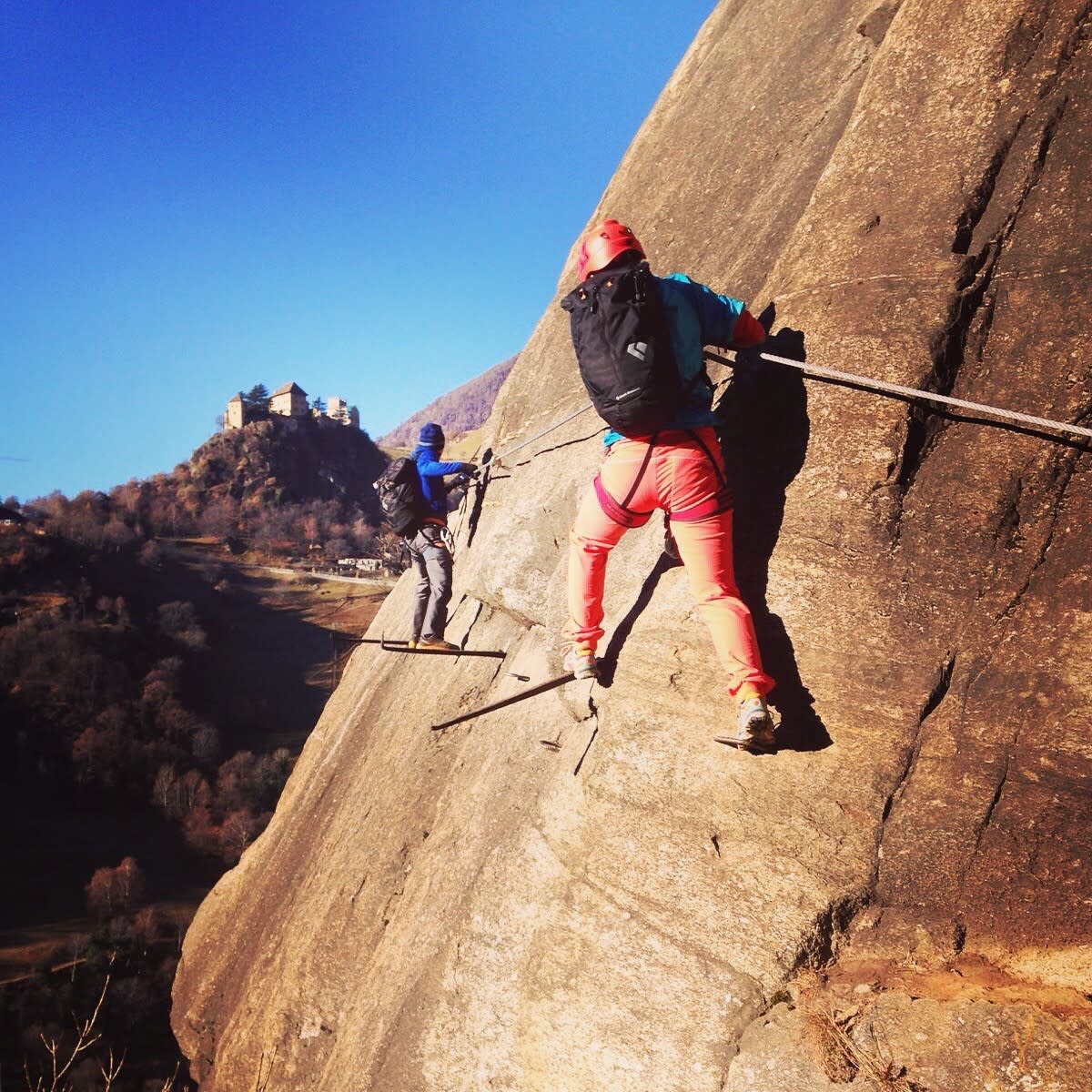
FOR THE BUCKET LIST: Europe’s best, original via ferratas
The Dolomites Cortina, Italy
The Dolomites are the gold standard of via ferrata. Many were built during the World War I when the mountainous region was the frontline between Italy and Austria. The Cortina area of the Dolomites has more than 30 via ferratas of varying length and level of difficulty.
Ferrata Lipella Tofana di Rozes, Italy
Aspiring mountaineers won’t want to miss the ‘Lipella’ at the Tofana di Rozes. The route takes you through the heart of the Dolomites via tunnels and traverses established by WWI soldiers. It follows a lengthy route up stepped terrain and scree-covered ledges, up to the 3,225-meter peak. The views of the spectacular Dolomite peaks are well worth the trip. Stop at one of the local huts for a glass of wine or cold beer after your climb.
Ferrata Olivieri alla Punta Anna Tofana, Italy
This ascent, almost entirely equipped with cables, follows the steep southern arête up Punta Anna, the large outcrop that looks onto the Tofana di Mezzo. Without a doubt this is one of the most interesting and beautiful via ferrata in the Dolomites due to its steepness, exposure and view onto the imposing south face of the Tofana di Rozes. The ferrata can be extended by combining it with others close by, including the ascent of the Tofana di Mezzo. You can reach the start by taking a chairlift.
Ferrata “Heini Holzer” Ifinger Merano 2000, Italy
Skiers love this via ferrata for its keen views of famous big mountain drops. Heini Holzer, the father of steep wall skiing, undertook a spectacular descent on the SW face of the Kleine Ifinger peak and the route is dedicated to his efforts. Geology-aficionados will appreciate that the route is located directly on the Periadratic seam—the most significant tectonic fault like in the alps. The Heini Holzer isn’t complete without a break at the Rifugio Kuhleiten, with mouthwatering food and traditional Italian hospitality.
Stuibenfall Klettersteig Tyrol, Austria
If you’ve ever wanted to climb a waterfall, this is the via ferrata for you. Located in Umhausen village in Austria’s Ötztal Valley, Stuibenfall Klettersteig follows the 150-meter Stuibenfall falls. At the top of the route, a suspension bridge crosses directly over falls—a thrilling event even for seasoned climbers. You start out with a “practice” bridge across the lower creek, and then climb up and around the thundering cascade of water. You’ll cross rope bridges, wander through forests, and ascend steep faces. There’s always good handholds and footholds and an easier detour at the end, making this a favorite for beginners. The descent is down an intricate metal walkway that is an impressive display of engineering.
Via des Evettes Chamonix, France
Chamonix is arguably the extreme sports capital of the vertical world. Alpinists, paragliders, speed wing flyers all flock to the small mountain town. Access to the mountains is easy as there are multiple cable cars that go from the valley floor to the high mountain peaks. There are at least 10 via ferratas in the Mont Blanc area, the newest is on the Domain Brévent-Flégère. The Via des Evettes was designed with families and beginners in mind. In Europe, via ferrata difficulty is rated on a scale from 1-5, with 1 being the easiest. The Via des Evettes is rated a 2, but if you decide you want more adventure, you can extend the day by adding another route. The via ferrata is free; if you need a guide the Guides de Chamonix are experts in mountain travel. Buy a return lift ticket for the La Flégère cable car (18 euros) for your trip back to town.

from Men's Journal https://ift.tt/2ZTcE8Z
via IFTTT








0 comments:
Post a Comment